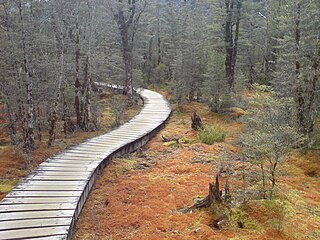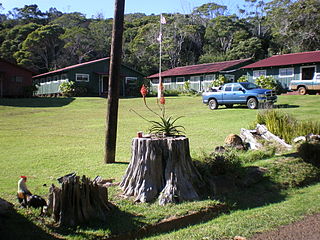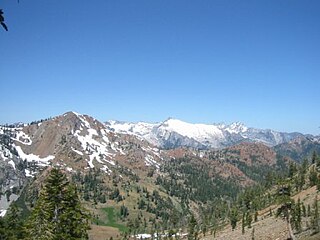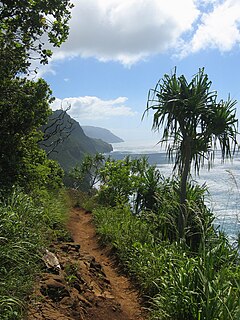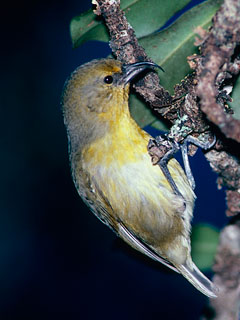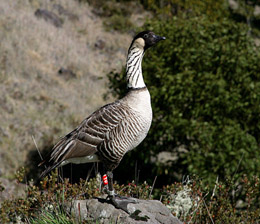| Kōke'e State Park | |
|---|---|
Kalalau Valley viewed from the Pihea Trail | |
| Location | Kauaʻi, United States |
| Coordinates | 22°7′49″N159°39′32″W / 22.13028°N 159.65889°W |
| Governing body | Hawaii Department of Land and Natural Resources |

Kōkeʻe State Park is located in northwestern Kauaʻi in the Hawaiian Islands. It includes the Kōkeʻe Museum at the 15 mi (24 km) marker on State Road 550, which focuses on the weather, vegetation, and bird life; a lodge which serves food and sells gifts; cabins for rent; and hiking trails. The park is just north of Waimea Canyon State Park at 22°7′49″N159°39′32″W / 22.13028°N 159.65889°W Coordinates: 22°7′49″N159°39′32″W / 22.13028°N 159.65889°W and includes 4,345 acres (17.58 km2) of mountainous terrain.
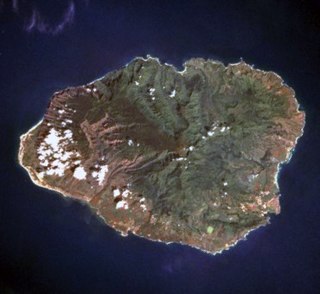
Kauaʻi, anglicized as Kauai, is geologically the oldest of the main Hawaiian Islands. With an area of 562.3 square miles (1,456.4 km2), it is the fourth-largest of these islands and the 21st largest island in the United States. Known also as the "Garden Isle", Kauaʻi lies 105 miles (169 km) across the Kauaʻi Channel, northwest of Oʻahu. This island is the site of Waimea Canyon State Park.

The Hawaiian Islands are an archipelago of eight major islands, several atolls, numerous smaller islets, and seamounts in the North Pacific Ocean, extending some 1,500 miles from the island of Hawaiʻi in the south to northernmost Kure Atoll. Formerly the group was known to Europeans and Americans as the Sandwich Islands, a name chosen by James Cook in honor of the then First Lord of the Admiralty John Montagu, 4th Earl of Sandwich. The contemporary name is derived from the name of the largest island, Hawaii Island.
Route 550 is a fourteen-mile (21 km) road stretching from Route 50 in Waimea to Kōkeʻe State Park on the island of Kauai.
Contents
The main attractions of Kōkeʻe State Park trails are the native vegetation, native forest birds, and the scenic cliffside views. Situated on a plateau between 3,200 and 4,200 ft (980 and 1,280 m), much of Kōkeʻe is a montane (infrequent frost) mesic forest (50 to 100 in or 1,300 to 2,500 mm annual rainfall with moist soil conditions) dominated by koa ( Acacia koa ) and ʻōhiʻa lehua ( Metrosideros polymorpha ) trees. The park receives around 70 inches (1,800 mm) of rain per year, mostly from October to May.

In geology and physical geography, a plateau, also called a high plain or a tableland, is an area of a highland, usually consisting of relatively flat terrain, that is raised significantly above the surrounding area, often with one or more sides with steep slopes. Plateaus can be formed by a number of processes, including upwelling of volcanic magma, extrusion of lava, and erosion by water and glaciers. Plateaus are classified according to their surrounding environment as intermontane, piedmont, or continental.

Acacia koa is a species of flowering tree in the pea family, Fabaceae. It is endemic to the Hawaiian Islands, where it is the second most common tree. The highest populations are on Hawaiʻi, Maui and Oʻahu. Its name in the Hawaiian language, koa, also means brave, bold, fearless, or warrior.

Metrosideros polymorpha, the ʻōhiʻa lehua, is a species of flowering evergreen tree in the myrtle family, Myrtaceae, that is endemic to the six largest islands of Hawaiʻi. It is a highly variable tree, being 20–25 m (66–82 ft) tall in favorable situations, and a much smaller prostrate shrub when growing in boggy soils or directly on basalt. It produces a brilliant display of flowers, made up of a mass of stamens, which can range from fiery red to yellow. Many native Hawaiian traditions refer to the tree and the forests it forms as sacred to Pele, the volcano goddess, and to Laka, the goddess of hula. ʻŌhiʻa trees grow easily on lava, and are usually the very first plants to grow on new lava flows.
At the end of the state road is a lookout onto the Kalalau Valley, once home to thousands of native Hawaiians. The valley was the backdrop for Jack London's short story Koʻolau the Leper.

The Kalalau Valley is located on the northwest side of the island of Kauaʻi in the state of Hawaiʻi. The valley is located in the Nā Pali Coast State Park and houses the Kalalau Beach. The Nā Pali Coast is rugged and is inaccessible to automobiles. The only legal ways to access the valley are by kayak or by hiking the Kalalau Trail.

Native Hawaiians are the Aboriginal Polynesian people of the Hawaiian Islands or their descendants. Native Hawaiians trace their ancestry back to the original Polynesian settlers of Hawaiʻi. In total, 527,000 Americans consider themselves Native Hawaiian.

John Griffith London was an American novelist, journalist, and social activist. A pioneer in the world of commercial magazine fiction, he was one of the first writers to become a worldwide celebrity and earn a large fortune from writing. He was also an innovator in the genre that would later become known as science fiction.
In October it is the home of a festival honoring Queen Emma of Hawaii. [1]
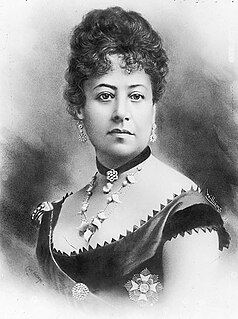
Emma Kalanikaumakaʻamano Kaleleonālani Naʻea Rooke of Hawaiʻi was queen consort of King Kamehameha IV from 1856 to his death in 1863. She ran for ruling monarch against King Kalākaua but was defeated.




